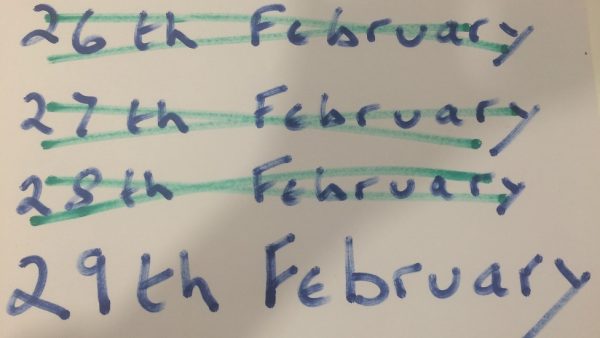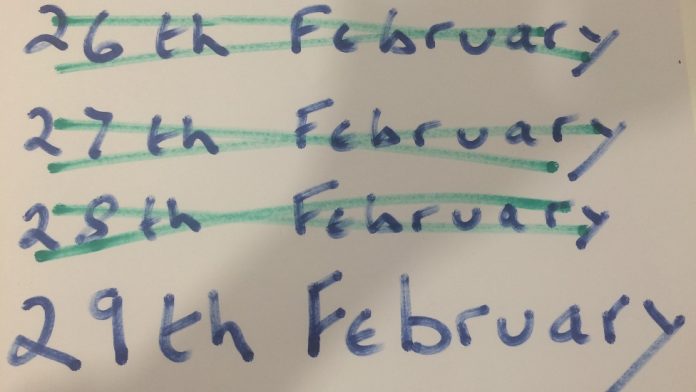Today is 29 February – Leap Day – which means we shall not see its like again for a further four years. By 2020, lots of things may have changed, or it may be a case of plus la meme chose. Below, Rising East writers give their best guesstimate of forthcoming events in the next four-year cycle.

Kay Ayed: IN OR OUT OF EUROPE, BRITISH GEO-POLITICS STILL LOOKS TO USA

Should we stay or should we go? The referendum on whether the UK should leave the European Union or stay in under the terms recently renegotiated by prime minister David Cameron, is set for 23 June 2016 – more than 40 years after Britain first joined. If Cameron’s deal is approved by the electorate, a package of changes will be implemented immediately. These measures include: recalculating child benefit payments to migrant workers; limiting in-work benefits for EU migrants during their first four years in the UK; and denying free movement rights to nationals of a country outside the EU who marry an EU national.
However, in the event of a Brexit, i.e. Britain’s exit, a new report by Open Europe shows that UK GDP could be 2.2% lower by 2030. While Eurosceptics argue that withdrawal would reverse immigration, save the taxpayer billions and free Britain from an economic burden, Europhiles counter that it would cause economic uncertainty and cost millions of jobs.
Close to presidential election time in the USA, the three candidates currently gaining all the attention are Donald Trump, Hillary Clinton and Bernie Sanders. Depending on which of these wins (if any), would Britain develop a different relationship with the US?
If Donald Trump entered the White House, the UK could expect to be more involved in wars. Trump has declared that he “will quickly and decisively bomb the hell out of ISIS… rebuild our military and make it so strong no one, and I mean no one, will mess with us.” And how exactly does this affect us? Well, let’s not forget that pretty much every foreign policy the US implements, the UK agrees to. On this basis, the possibility of finding ourselves embroiled in World War Three can hardly be ignored.
Bernie Sanders begs to differ. In December 2015, he posted: “The test of a great and powerful nation is not how many wars it can engage in, but how it can resolve international conflicts in a peaceful manner. I will move away from a policy of unilateral military action and regime change, and toward a policy of emphasising diplomacy, and ensuring the decision to go to war is a last resort.” If Sanders does win, Britain’s ties to the US will either weaken – since many Brits seem to love military action – or his desire for democracy will influence Britian’s approach to the wider world, possibly for the better.
Sanders even pointed fingers at former president George W. Bush for leading the nation into a misguided war in Iraq. Sanders said this had bred “massive instability in the region….chaos which allowed the rise of ISIS.”
Hillary Clinton is somewhere in the middle. On the hawkish side, she pledges that “defending our values and keeping us safe will be my top priority”. Besides “maintaining a cutting-edge military and strengthening our alliances”, her prospectus includes “cultivating new partners, standing up to aggressors, defeating ISIS, and enforcing the Iran nuclear agreement.” Clinton’s policies do not seem as extreme as Trump’s, but definitely sound more realistic than Sanders’. If she wins, it means Britain’s alliance with the USA is likely to carry on largely as before.
The extent of public action against government policies is hard to guage. Only a couple of days ago, thousands of anti-Trident protesters gathered in Trafalgar Square – a big crowd but nowhere near the size of the CND crowd on the streets in 1984 (aprrox 250,000). Junior doctors enjoyed widespread public support when they took strike action against the attempted imposition of seven-day working arrangements in the NHS; and a petition confirming ‘no confidence in Cameron’ received nearly 200,000 signatures – but MPs still refused to address it in Parliament.
In view of this, perhaps there is only thing we can confidently say about UK politics: in the next four years the Westminster Village will continue to ignore, dismiss or downplay the hopes and fears of the majority population.
Sid Ouared: MELTDOWN IN UK PARTY POLITICS

Four years on, what will the political parties look like? Internal conflicts are evident within both Labour and the Conservatives. The level of hostility between David Cameron and his Eton chums over the EU referendum, suggests that Cameron’s succession will be anything but smooth. Meanwhile Labour’s new leader continues to pose problems for the party – Jeremy Corbyn is as unpopular with New Labour-vintage MPs as he is popular with Labour activists (young and old); and nobody really knows what the People think. This unstable situation is further complicated by the possibility of Labour being outflanked from the Left by the Scottish National Party (SNP), led by Nicola Sturrr’geon – and to think the SNP used to be decried as ‘Tartan Tories’.
It’s chilling to imagine yet another term with the Conservative Party in power. With current prime minister David Cameron set to step down as Tory leader come the next general elections, those beside him will be sticking their elbows out (and the knives in), hoping to secure the keys to the door of No 10. Home secretary Theresa May has advanced her case during the past six years by shaking up the Home Office and shaping up the justice system. If her Investigatory Powers Bill is anything to go by, our civil liberties are also set to be knocked around. Then there’s the shark-eyed chancellor George Osborne, boo’ed when he showed his face in the Olympic Stadium in 2012, and still unlikely to win any popularity contests in East London. With his tough austerity measures hitting working families hard, Osborne as prime minister would make life more difficult for millions of…the kind of people he just doesn’t care about. But with George currently siding against Boris and sticking with David (just call him ‘Dave’ when talking to the chavs), if the Brexit referendum goes against the p-m, it could go just as badly for the chancellor
Meanwhile, on the other side of the House….New Labour seems like the political equivalent of The Undead. Despite the debacle of the War on Iraq, Tony Blair’s spectre still stalks the corridors of Westminster, and the sweet old man from Islington North, 30 years a constituency MP, just does not know how to strike the final blow. Jeremy Corbyn will have to work extremely hard to counter the charge that he and his frontbench team are ‘erratic’, untested and unelectable. On the other hand, Corbyn has already shaken up Prime Minister’s Questions and done more to bring young people into politics than anyone else since…Tony Blair.
Aaaghhh! In some shape or form it seems The Nightmare From Granita will still be with us in 2020!
Cally Skinner: TOURISM POPS UP

Tourism could change drastically in the next four years as pop-up shop and galleries have the potential to become increasingly popular.
Instead of regular shops taking up permanent residence the new trend will be pop-up shops opening for a limited time only. The effect is likely to be positive – more people will visit more often because there is more new stuff to see (and buy); also the sheer diversity of pop-ups means that different tastes, ages and cultures are all catered for.
Shoreditch has already become the Oxford Street of pop-ups and draws in more tourists than Bond Street. Locations like Boxpark, an established venue for short-term enterprises, can hardly keep up with rising demand.
Meanwhile the old-school hawkers outside Indian restaurants in Brick Lane are likely to go into decline as tourists become more sussed and less likely to be persuaded by the offer of free poppadums and half-a-pint of lager – unless this kind of ‘persuasion’ is re-branded as ‘all part of the 1970s curry experience’ complete with flock wallpaper and prawn cocktail starter.
Street art, already brightening up hundreds of buildings, will become ever-more lurid in the attempt to capture tourists’ attention. More cafes like Crème Egg will pop-up to offer unique treats for obsessive food lovers.
East London is setting the trend for the next generation of tourism; where we are now, central London will follow in time for 29 February 2020.
Sydney Kauffman: STREET MARKETS AIN’T WOT THEY USED TO BE

Street markets are part of yer actual East End tradition, aren’t they? Never going to go away, are they, me ole cock sparrer? In fact East London’s street markets are changing fast, and the traditional species is now almost as out of place as Dick Van Dyke doing a cod Cockney accent in Oliver.
On a good day, wandering from market to market in Shoreditch can be a trip around the world via the flavours of East London’s culinary hub, or an adventure to find the newest piece of upcycled vintage street art.
However, it is almost guaranteed that while on this trek through the back streets, your patience will be severely tested by swarms of tourists who appear, seemingly from nowhere. Repeatedly getting cut off by parents with mega-buggies who aren’t paying attention and groups of teens running from one overpriced shop to another, is about as calm as it gets.
Fings ain’t wot they used to be among the barrow boys (and girls) of East London. Increasingly, street markets are retro, vintage, heritage, gentrified experiences modified for the incoming middle classes; meanwhile those in need of bare necessities are heading for Aldi, Lidl, Poundland and, now – coming to a high street near you – The 25p Shop!
Gone are the fruit and veg stalls, along with the independent business owners and weekend hustlers. Gone is the local feel of what East London stands for, replaced by businesses charging £6 for a bowl of cereal. Gone is the exclusivity and individuality of each market, replaced by a generic upscale identity.
Ten years ago tourists rarely ventured into the East at all. Four years ago the Olympics took hold of London with both hands and with that came ‘regeneration’, aka accelerated gentrification. Streets were cleaned, businesses polished, and the rabble was tucked away.
Today Shoreditch is filled with people who dress down to make out they can’t afford the £700 p.w. flat with a city view which they are actually renting; and some local bars charge more for pretentious cocktails than their counterparts in the West End. Shoreditch doesn’t want to become city slicker territory – far too corporate. So it cultivates an aura of ‘traditional’ eccentricity. But suitably ‘distressed’ weirdness is a far cry from the time-honoured distress of people struggling to get by; hence the commerciality of weirdness and the desire for the ‘old ways’ are clashing.
I have little doubt that when the next leap year swings round, the Shoreditch area will have been sold for everything its worth, and the hipster fad will have moved on to another unsuspecting playground.
Lina Shariff: SURVIVAL STYLE SHOULD BE KILLED OFF
Looks like we’ll all spend the next four years looking like we have to fight to survive.
Kanye West recently showcased his third collection “Yeezy Season 3” in front of 15,000 people at New York’s Madison Square Gardens.
His line is sports-inspired clothing with large sweaters, military-style boots, and jackets coloured in a neutral palette of olive, beige, yellow, grey and white. Marketed in collaboration with Adidas, this high-end collection looks like something the great unwashed would wear when appearing in a dystopian movie.
Meanwhile it was announced earlier today that this year’s Oscar winner for costume design is Jenny Beavan, who designed the outfits for Mad Max: Fury Road – the latest picture in the dystopian Mad Max franchise.
So the current fasion trend is to dress like we have to kill or be killed; even though you have to be well and truly gentrified to keep up with today’s fashionable prices.
It would be more honest and true if those who are well-off (financially), didn’t spend so much money giving the impression that theirs is a life and death struggle without remission.
I for one would prefer it if the super-rich spent the next four years indulging in super-luxury – silk, cashmere and plenty of diamonds and pearls. But I dare say the ‘survivalist’ style will take the best part of four years to wear off.

